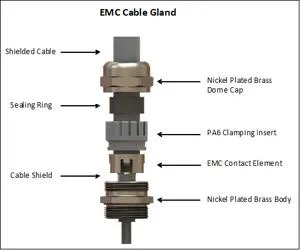EMCケーブルグランドは、電気機器を電磁干渉から保護すると同時に、ケーブルの確実な接続を実現するために設計された特殊な装置です。これらのコンポーネントは、電気通信から医療工学システムに至るまで、様々な産業および技術アプリケーションにおける電磁両立性の維持に重要な役割を果たしています。
EMCケーブルグランドとは?
EMCケーブルグランド は、電磁干渉(EMI)から電気システムを保護するための重要なコンポーネントとして機能する機械式ケーブルエントリーデバイスです。これらの特殊なグランドは、ケーブルと機器ハウジング間の安全な接続を作成し、様々な技術環境における電磁両立性(EMC)を保証します。EMCケーブルグランドは、360度の遮蔽接続とケーブルの編組シールドとインターフェースする金属接点片を組み込むことで、電磁波を効果的に管理し、電磁波をアースに導き、敏感な電子部品への障害を防ぎます。
コンポーネントと構造

- 本体:通常、ニッケルメッキを施した真鍮またはステンレス鋼製で、構造的な支持と導電性を提供する。
- グランドナット:ケーブルを固定し、密閉性を高める。
- 導電性スプリングまたはコンタクトピース:ケーブルの編組シールドとの360度の接触を保証する。
- シーリングインサート:多くの場合ネオプレンまたはポリアミド製で、環境からの侵入を防ぐ。
- クランプインサート:ストレインリリーフとケーブル保持を提供。
この構造により、EMCケーブルグランドは電磁干渉を効果的にシールドすることができ、同時にIP68規格の防塵・防水保護も提供します。この設計により、迅速な組み立てと確実な設置が可能となり、堅牢なEMC保護を必要とする様々な産業および技術用途に最適です。
主な特徴とプロテクション
EMCケーブルグランドは、真鍮やステンレス鋼のような堅牢な材料で設計されており、過酷な環境条件に耐えるように設計されています。これらのデバイスは、-40°C~120°Cの優れた動作温度範囲とIP68定格による包括的な保護を提供し、湿気、液体、腐食、および埃の侵入に対する耐性を保証します。グランドの構造には、通常3つの主要コンポーネントが含まれます:
- しっかりと固定するための金具
- ケーブル保護用シーリング・インサート
- 圧縮と密閉のためのキャップナット
この設計は、RFI/EMIシールドを提供するだけでなく、導電性機能を提供し、EMCケーブルグランドを様々な産業および技術用途における信号の完全性を維持し、敏感な電子機器を保護するために不可欠なものにしています。
業界を超えたアプリケーション
EMCケーブルグランドは、電磁両立性の維持に重要な役割を果たすため、様々な業界で広く使用されています。これらの特殊なデバイスは、次のような用途に不可欠なコンポーネントです:
- クリアな信号伝送を保証する電気通信機器
- メディカル・エンジニアリング・システム、繊細な診断・治療機器の保護
- 産業オートメーションのセットアップ、制御システムを干渉から守る
- 電気自動車とハイブリッド車、車載電子機器の完全性維持
- ビデオとデータの品質を維持する監視システム
- 太陽光発電モジュール、保護インバータ、監視装置
- 信頼性の高いエネルギー伝送を保証する配電システム
EMCケーブルグランドは汎用性が高いため、電磁干渉により機器の機能やデータの完全性が損なわれる可能性がある環境では不可欠です。EMCケーブルグランドの導入は、このような多様な分野における業務効率と信頼性の維持に役立ちます。
動作原理と利点
ファラデーケージの原理で動作するEMCケーブルグランドは、ハウジング表面上で電磁波を効果的に偏向させ、内部で露出したケーブルを保護します。絶縁ケーブルがグランドに入ると、その金属コンタクトピースがケーブルの金属絶縁編みメッシュと接続し、電磁干渉波をグランドラインに導き、干渉源を退避させます。
これらの特殊な腺の導入は、以下のような多くの利点をもたらす:
- 敏感な電子部品を電磁干渉から保護
- 適切な引き抜き抵抗による連続クランプ
- シグナル・インテグリティとパワー・インテグリティの維持
- エンクロージャーへの重要な移行部での保護強化
これらの利点は、機械やシステムの無故障を保証し、EMCケーブルグランドを電磁シールドソリューションの重要なコンポーネントにしています。
EMCケーブルグランドの設置ガイドライン
EMCケーブルグランドを正しく設置することは、最適な電磁両立性と保護を確保するために極めて重要です。このプロセスには通常、以下の重要なステップが含まれます:
- ケーブルの直径、環境条件、必要な保護レベルに基づいて、適切なEMCケーブルグランドを選択してください。
- ケーブルを準備するには、外側のシースを剥いてシールドを露出させる(通常5~10mm)。
- グランドを通してケーブルを挿入し、接地スプリングが露出したシールドに接触することを確認する。
- ロックナットを使ってグランドをエンクロージャーに固定し、密閉を作る。
- キャップの締めすぎやケーブルの回転に注意し、導通を確立する。
設置の際には、メーカーのガイドラインと関連する実施規範に従うことが不可欠です。適切な設置により、効果的なEMI保護が保証され、エンクロージャのシーリングの完全性が維持され、ケーブルに適切なストレインリリーフが提供されます。
Youtubeでもっと見る
標準ケーブルグランドとの比較
EMCケーブルグランドは、標準的なケーブルグランドと比較して優れた電磁気保護を提供し、電磁干渉に敏感なアプリケーションに不可欠です。標準的なケーブルグランドが主に環境保護とストレインリリーフを提供するのに対し、EMCグランドは追加機能を組み込んでいます:
- 効果的なシールドのためのニッケルメッキ真鍮やステンレス鋼のような導電性材料
- ケーブルの編組シールドと360度接触し、継続的なEMI保護を確保
- 特に高い周波数帯域で高い減衰値
- 高いシールド電流の確実な放電を可能にする、より大きな通電容量
これらの特徴により、EMCケーブルグランドは、産業オートメーション、電気通信、医療機器設置のような、電磁干渉が大きい環境に適している。しかしながら、EMCケーブルグランドは一般的に高価であり、標準的なケーブルグランドよりも精密な取り付けが必要になる場合があります。



